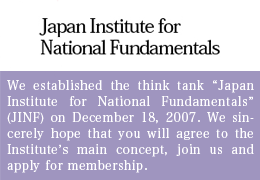Japan’s New Administration Must Exercise Political Leadership in Reconstruction of Fukushima
On January 13, I visited Fukushima Prefecture, joined en route by Ms Yumiko Nishimoto, chief representative of a non-profit organization called “Happy Road Net.” We were headed to the Fukushima No. 2 nuclear power plant.
Although the Fukushima No. 1 nuclear power plant was devastated by the explosions of its reactors on March 11 of 2011, the No. 2 plant survived, having sustained the magnitude 9 earthquake and subsequent tsunami. The main purpose of my visit was to find out why the No. 2 plant withstood the disaster and how things are there today.
However, before our group reached our destination, we met with a male evacuee in his early 40s, whom I have been staying in touch with since March 11 and the look of him caused me a good deal of concern. He was unusually withdrawn and depressed. I had never seen him so dejected.
Before the accident at the No. 1 plant, he was a successful businessman, running a variety of enterprises in the town of Namie, including a lumbering operation, a restaurant, and a reception hall for weddings and funerals, employing several hundred employees. Until our last meeting, he had always struck me as a forward-looking person of firm character. This time, however, there was something distinctly different about him.
So I decided to take a later train back to Tokyo and have a leisurely dinner with Ms Nishimoto and the former businessman from Namie – who will remain anonymous – both of whom kindly accompanied me throughout the day. The dinner turned out to be a lively affair, attracting a large crowd, including some residents from the disaster-hit neighboring towns of Tomioka and Hirono who could not be with us during the day, as well as a group that drove three hours from Minami Soma City, taking a three-hour detour in the absence of a direct route to Namie. Each of those present continues to live a tough life following the disaster, but the conversation took a lively course now that people sharing similar experiences were together. When I asked the man from Namie what was the matter during the dinner, all eyes were suddenly turned on him, lovingly and compassionately. Looking a bit self-conscious, he started talking, making frequent pauses. It was an earnest plea for help that deeply touched me.
He explained that, because the forests are heavily contaminated by radiation, the authorities have prohibited deforestation, making dim the prospects for continuing his lumbering operation, which has been in the family for several generations. He may yet be able to restart lumbering after a certain span of time, and it may just be possible to reopen his restaurant and reception hall while waiting to restart lumbering. However, the town assembly of Namie decided last October 12 that, in view of high and lingering radiation levels, the town’s former residents would not be allowed to return for at least the next five years. Consequently, he has no choice other than restarting business elsewhere. Although he does not pay salaries because his employees have no work to do, he has yet to discharge them. This requires him to continue to regularly cover insurance premiums and pay into the National Pension on their behalf. As a former proprietor, he can’t sit still, he confesses, itching to do something to break the stalemate.
Slavutych, Dream City for Chernobyl Victims
In the meantime, his wife and daughter have sought refuge in Tokyo, the latter slated to take her entrance examinations for high school sometime soon. Should she get into to a high school in Tokyo, there may be a possibility of the mother and daughter having to decide to live there indefinitely.
On the other hand, his parents have purchased a new house for themselves in Fukushima City. His father, eager to not pressure his son anymore, has told him not to feel compelled to continue the family business. But it was heartrending for the son to have to hear his father make such remarks.
The son now lives alone with a dog in a rented house in Fukushima City. His was a very happy three-generation household before. But now, it has been split in three, the possibility of them living again in a single household becoming increasingly slim.
Let’s look at the reality of the town of Namie in order to better understand his anxiety. The town assembly of Namie, much of it within 30 kilometers of the No. 1 plant, proposed last December that the whole town be divided into three zones – (1) areas for which evacuation orders are ready to be lifted; (2) areas in which habitation would be restricted; and (3) areas where residents are expected to face difficulties in returning. The annual accumulated radioactive dosage is expected to be under 20 millisieverts for Zone (1), 20-50 millisieverts for Zone (2), and above 50 millisieverts for Zone (3). The businessman’s house is in the restricted area – Zone (2) – making it difficult to return at least for the time being in view of the area’s previous radiation level. He will simply have to start rebuilding his life not in his own hometown but elsewhere. He has every reason to be upset about the just ended two-year-plus administration of the Democratic Party of Japan (DPJ) for the extremely shaky guidelines and haphazard assistance schemes which it dealt the victims of Fukushima, leaving them in these wretched conditions. He admitted being “nearly worn out,” with no real prospects in sight for the future – for himself or his family.
Everybody nodded as he haltingly explained his plight. “Hang in there,” a younger member of his circle told him in a local dialect. “We will be with you all the way.”
With the Liberal Democratic Party (LDP) back in power, what should the new administration do to cope with the grossly delayed reconstruction of Fukushima? I believe the new administration can learn much from the example of the city of Slavutych in Ukaraine cited by Professor Tadashi Narabayashi of Hokkaido University in a recent Internet TV show hosted by myself. (I have been hosting this new show live every Friday night since last October.) Prof. Narabayashi introduced Slavutych as a “dream city” in Ukraine that has overcome the Chernobyl disaster.
It was in April 1986 that a catastrophic nuclear accident occurred at the Chernobyl Nuclear Power Plant in Ukraine, releasing radioactive particles into the atmosphere in quantities that dwarfed Fukushima. As a result, the radioactive dosage in Slavutych, located some 50 kilometers from Chernobyl, rose above the level of natural radiation. However, judging that such a dosage would not be harmful to the human body, the Ukrainian government decided to build a brand new city for the former employees of Chernobyl and their families four months after the accident. The Ukrainian government resolved to make Slavutych not just a city for relocation, but a full-fledged dream city. People began taking up residence starting in March 1988 – a feat accomplished less than two years after the nuclear catastrophe. Prof. Narabayashi explains the city, now inhabited by 24,720 residents, as follows:
“It is an exciting new city that attaches great importance to children. There is a kindergarten every 400 meters. Sidewalks, bicycle roads, and roadways are separated by roadside trees, turning Slavutych into a lovely green city. Each kindergarten is complete with a swimming pool, a computer room, and an indoor playground. The city also has inaugurated a radiation medical research center, registering some 23,000 former Chernobyl residents exposed to radiation, who receive free counseling and treatment. In addition, it has also set up a computerized embroidery factory in order to industrialize embroidery, which is a special product of the district.”
Time to Exercise Political Leadership
The city is lined with low-rise condominiums and fashionable detached houses featuring red brick walls.
“As for accommodations, the city has given preference to former employees of the nuclear power plant and their families, offering housing free of charge. The detached houses are specifically for families with three or more children. The ‘dream city’ has thus created an environment in which many children are born. At present, these housing complexes also accommodate ordinary people who have nothing to do with the old nuclear power station. Agriculture and livestock farming are thriving.”
However, it is not that Slavutych itself is not contaminated, as a low level of radioactive dosage is monitored there. But not one pasture-fed cow has yet to be put down because of radiation exposure. The meat and milk from the cattle raised in Slavutych are fit for consumption, with dairy farmers proudly making a living. Explains Prof. Narabayashi:
“There is a dark blue pigment called Prussian blue, which is harmless to the human body and is sanctioned in Japan as well. This pigment has the effect of discharging cesium out of the human body. For two months leading up to shipment, the dairy farmers in Slavutych give a certain quantity of Persian blue to their pasture-fed – and therefore radiation-exposed – cows, successfully eliminating a significant amount of cesium from the meat and milk. In the two months, the amount of cesium generally drops to 1/17 the original level, making the meat and milk safe. In Japan, dairy farmers in and around Fukushima Prefecture disposed of huge quantities of cesium-contaminated cow’s milk, as you recall. What a waste it was. But if milk was really contaminated to such an extent as to be truly harmful to the human body, it was a gross mistake to dump the milk into the drains. It should have been duly processed before disposal at proper facilities.
Comments Ms Nishimoto excitedly:
“A city-building plan like Slavutych – that is exactly what we need. Fukushima Prefecture has virtually unlimited space to relocate large groups of victims. As long as the government is determined to present to us an invigorating vision such as the construction in Fukushima of a dream city like Slavutych, I am certain that there won’t be any chance of ambitious young people – such as our friend from Namie – feeling dejected.”
Slavutych has become possible because the Ukrainian government exercised true political leadership. What is now expected of the LDP administration is exactly the type of leadership which the DPJ was so shamefully devoid of.
(Translated from “Renaissance Japan” column no. 543 in the January 31, 2013 issue of The Weekly Shincho)








